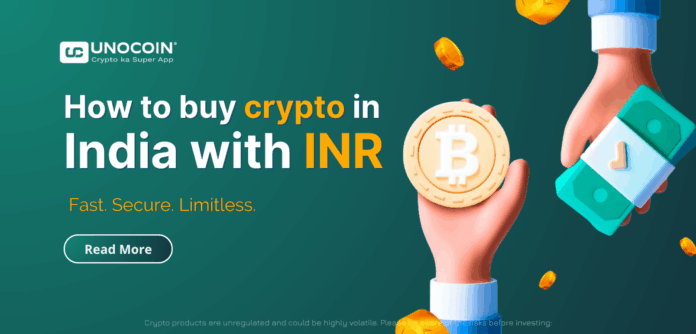Buying cryptocurrency in India with INR is now straightforward — if you know the right steps. In this guide, we’ll walk you through how to buy cryptocurrency in India with INR: from choosing a trusted exchange and completing KYC to depositing INR (UPI, bank transfer) and finally buying coins on INR trading pairs. This step-by-step approach keeps your funds secure and helps you avoid common mistakes.
Why buy with INR?
Buying directly with INR removes unnecessary conversion steps (no USD/USDT bridge), reduces fees and speeds up settlement — especially useful for retail Indian investors buying small amounts frequently. Many Indian exchanges support INR pairs like BTC/INR and ETH/INR, making execution simpler.
Step 1 — Choose a trusted Indian exchange
Pick an exchange with strong local credentials, clear KYC processes, transparent fees and good customer support. Unocoin has served Indian users since 2013 and provides INR trading and wallet services.
What to check:
-
Local INR pairs (BTC/INR, ETH/INR)
-
Simple INR deposit methods (UPI, NEFT/IMPS)
-
Low/clear trading fees and withdrawal policy
-
Customer support & uptime
Step 2 — Create account & complete KYC
Register using your mobile and email, then complete KYC (PAN + Aadhaar or passport + proof of address) — KYC is standard across Indian exchanges to comply with AML rules and to enable INR deposits and withdrawals. Expect ID verification, selfie checks and bank account linking.
Quick tip: Use the exact name on your bank account and PAN to avoid payment failures.
Step 3 — Deposit INR
Most exchanges accept INR via multiple rails. Common deposit methods:
-
NEFT/IMPS/RTGS or Virtual Bank Deposit — good for larger transfers or when UPI limits apply.
-
Third-party payment partners / Netbanking.
Unocoin provides clear support documentation on depositing INR and using virtual bank deposit options for faster crediting.
Step 4 — Choose the right market & order type
INR pairs (recommended for Indians): BTC/INR, ETH/INR, BNB/INR — buy directly in rupees. This avoids conversion fees from INR→USDT→coin. Many Indian exchanges list common INR pairs.
Order types explained (simple):
-
Market order: Instant execution at current price (fast but slippage possible).
-
Limit order: Set your desired price; fills when the market reaches it (better control & often lower fees).
-
Stop-loss / Take-profit: Useful for risk management.
Pro tip: For first buys, place a small limit order to avoid paying market spread during volatility.
Step 5 — Confirm, secure & move to wallet if holding long term
After purchase, funds will appear in your exchange wallet. For long-term holding, consider moving crypto to a secure non-custodial wallet (hardware or trusted software). Exchanges are convenient for trading, but personal custody reduces counterparty risk.
Security checklist:
-
Enable 2FA (Google Authenticator)
-
Use strong passwords and unique email accounts
-
Consider cold storage (Paper wallet) for large holdings
Costs & fees to watch
-
Trading fees: Maker/taker structure — check exchange schedule.
-
Deposit/withdrawal fees: INR bank charges or UPI limits.
-
Spread: Difference between buy and sell price — wide during low liquidity.
Always review the fee page before transacting to avoid surprises.
Taxes & record keeping
Crypto gains are taxable under Indian law and require accurate records for purchases and sales. Maintain trade receipts, deposit vouchers and KYC documents; consult a tax professional for personalised advice. (This is not tax advice.)
Common problems & solutions
Deposit not credited? — Check account ID & match name & transaction UTR. Contact exchange support with proof. Unocoin
KYC stuck? — Re-upload clear ID scans; use recommended file formats.
High fees? — Use INR pairs, limit orders, or loyalty programs if available.
Example — Buy ₹100 of Bitcoin
-
Login → Go to BTC/INR page.
-
Click Buy, enter ₹100.
-
Choose Market Instant or Exchange (set price).
-
Confirm & check wallet balance.
(You can follow Unocoin’s beginner guide for screenshots and the app flow.)
Why choose INR rails?
Buying directly with INR is cheaper, faster and simpler for Indian users — it avoids stablecoin bridges and makes bookkeeping easier for tax purposes. Using trusted Indian exchanges reduces friction and supports INR withdrawals back to your bank.
FAQ
Q1: Can I buy crypto instantly with UPI in India?
Many exchanges support instant UPI deposits; amounts and limits depend on your bank and platform. Always follow the exchange deposit instructions.
Q2: Which coins can I buy directly with INR?
Popular INR trading pairs include BTC, ETH, ADA, SOL and 100+ other major coins, depending on the exchange. Check the Unocoin exchange markets page for the full list.
Q3: Is KYC mandatory?
Yes — KYC is required on Indian exchanges to comply with AML regulations and to enable INR deposits/withdrawals along with crypto deposits & withdrawals.
Q4: How secure is Unocoin?
Unocoin has been operating in India since 2013 with local support and INR services — follow security best practices like 2FA and cold wallets for long-term storage.
Please find the list of authentic Unocoin accounts for all your queries,
links: linktr.ee/unocoin
Disclaimer: Crypto products are unregulated and could be highly volatile. Please be aware of the risks before investing. To ensure that consumers who deal in crypto products are not misled, they are advised to DYOR (Do Your Own Research)







